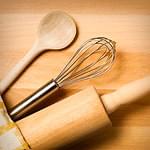
A stockpot is typically the largest pot in the kitchen. You can buy them in sizes starting at 8 quarts, which is a fine size for cooking pasta, but for a great multipurpose, large pot, we recommend a 12-quart. It’s big enough to make about six quarts of stock or broth (you’d think more, but the ingredients that go into it take up a lot of space), a big pot of soup, or a double batch of chili or ragù. It also has enough room to cook whole ears of corn, boil lobster or crabs, or slowly simmer a bumper crop of garden tomatoes into sauce.
What to look for
Heavy-duty bottom.About half of the pots we tested had an aluminum disk base; the other half had an aluminum core running across the base and up the pot’s side (making it “clad”). Both delivered even, controlled browning.
Roomy, secure handles.When you’re lifting a pot this size filled with 6 pounds of chicken parts and 6 quarts of hot broth, you need substantial handles that are roomy enough to grip with thick potholders.
A rounded rim,which allows liquids to cascade out smoothly.
Tall vs. stocky
As we set out to evaluate stockpots, we noticed one significant difference among those on the market—shape. Some are tall and narrow, others as wide as (or wider than) they are tall. Traditionally, a stockpot is deeper than it is wide so that simmering water can bubble up through bones, meat, fish, or vegetables, extracting and infusing flavors over a period of time without much evaporation. Yet, after lengthy testing, we didn’t find a difference in flavor or yield of broths made in the wide stockpots versus those made in the tall, narrow varieties, so we have included both here.
The two styles of pots differ mainly in ease of use. We found that we preferred the wider pots, because their lower sides made it easier to monitor, manipulate, and stir foods. With the taller pots, using tongs to turn pieces of browning meat required plunging a hand into a deep, narrow vat of splattering fat. And because they’re so tall, they’re hard to see into.
We tested eight stainless-steel stockpots between 11-1/2 and 12-1/2 quarts in size. Our four top picks range in price from $130 to $395. You can pay less for a stockpot and still be able to make a reputable broth; most important are your ingredients. But if you’re inclined to invest in a pot, spending a little more on one of our favorites will deliver controlled browning, so you’ll end up using it more often.
Top Picks
All-Clad LTD12-quart stockpot
$380,Cutleryandmore.com
Dimensions: 10-1/2 inches wide, 7-3/4 inches tall
Weight: 5 lb. 12 oz.*
We preferred this pot to All-Clad’s stainless “tall” stockpot, not only in terms of versatility but also for how well it controlled heat—steadily and evenly. The riveted handles were easy to grasp. This pot has a stainless-steel interior, and the black hard-anodized exterior was easy to keep looking clean. A rounded edge meant hot broth poured out smoothly.

Cuisinart Multiclad Pro12-quart stockpot
$130,Cookswares.com
Dimensions: 11 inches wide, 7-1/2 inches tall
Weight: 6 lb. 2 oz.*
The relatively wide, open shape of this pot made it easy to maneuver browning meats and stir sauteing onions. Yet it wasn’t so wide that the broth reduced any more than it did in the other pots. The riveted stainless-steel handles allowed for a secure grip, even with bulky potholders. The rounded edge made for smooth, drip-free pouring. We also liked the brushed stainless-steel finish, which hides streaks.

Tramontina Tri-Ply Clad12-quart stockpot
$180,Kitchenfantasy.com
Dimensions: 10-1/2 inches wide, 9 inches tall
Weight: 5 lb. 8 oz.*
This pot has more of a classic stockpot shape, taller and not as wide as the other pots we recommend. It’s open enough to feel accessible, whether you’re browning meat, sauteing vegetables, or just reaching in to clean it out. While the three-layer aluminum-core base gives it a substantial feel, this is the lightest of the four pans. Riveted handles provided a strong hold.

Viking stainless-steel12-quart stockpot
$395,Metrokitchen.com
Dimensions: 11 inches wide, 7-3/4 inches tall
Weight: 6 lb. 15 oz.*
用五层的导热金属,this pot maintained a controlled feel, even at high heat. On the flip side, those layers made for a heavy pot, at nearly 7 pounds. Its relatively wide shape made working in the pan.and cleaning it out.easier than working in a taller stockpot. The riveted handles provided a comfortable, secure grip. There is no rounded edge to this pot’s rim, so ingredients didn’t always pour out smoothly.

*Weights are without lids.
How we tested
- We evaluated each pot’s overall performance in making broth, including its ability to hold a steady, gentle simmer and the depth of taste in the resulting broth.
- We made a large batch of ragu, evaluating how evenly and steadily the pots browned onion and beef.
- We browned beef shanks to assess how well and evenly each pot conducted heat and whether the bottoms scorched.
- We cooked corn on the cob, measuring how long each pan took to come to a boil as well as return to a boil after the corn was added.
- We assessed handle comfort and ease of pouring.























Comments
Leave a Comment
Comments
-

EvaDBryant | 01/11/2019
-

SharonJFrancis | 12/08/2018
-

StephenTijerinaC | 11/20/2018
-

PearlGWilson | 11/03/2018
Show MoreLove to eat this..
Thanks for sharing this dish!
Thanks for sharing this recipe.
Liked it very much!